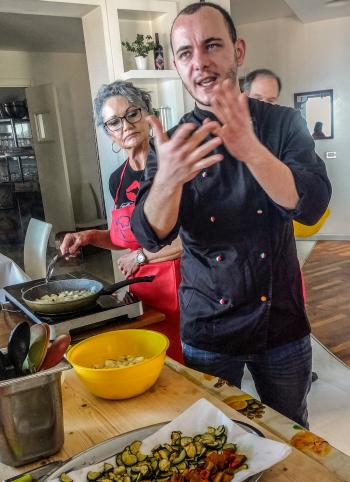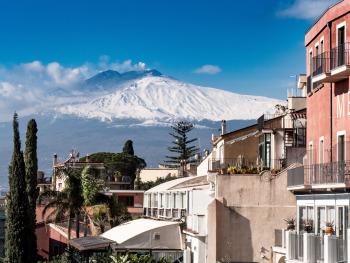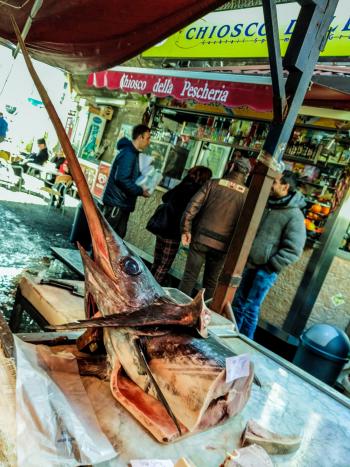“Cooking in Sicily” with Road Scholar
This article appears on page 38 of the April 2020 issue.
At the beginning of February 2019, my wife, Sandra, and I escaped the cold of Minneapolis for the warmer Mediterranean climate of Taormina, Sicily, traveling with Road Scholar (Boston, MA; 800/454-5768, www.roadscholar.org) on a 10-day trip titled “Cooking in Sicily.” The tour was organized around four cooking school sessions and a number of excursions around eastern Sicily, including a winery tasting and lunch.
Our group of 10 travelers would be based in Taormina, on the east side of the island, right at the base of Mt. Etna.
The tour
My wife and I have now been on five Road Scholar trips and have been very satisfied with every one. They seem especially good for single travelers, as we’ve been joined by several singles on every trip. (Of the 10 travelers on this trip, six were singles.)
Transportation was on a newish and comfortable minibus that gave us plenty of room. Everything was well organized and ran on time. (The perpetually late people who often seem to be attracted to tours were apparently occupied elsewhere.)
The weather was a coolish 60°F, plus or minus, but for those escapees from below-zero Minnesota, that seemed quite fine! We had a little rain, but only on one day.
A focus on food
Non-cooking-school meals were enjoyed in various restaurants, usually a set menu — none of the dreaded tourist buffets. Unlimited pitchers of good red and white wine were provided at every meal.
Three of our four cooking-school meals (on days 3, 6 and 7) were elaborate lunches — the big meal of the day in Sicily — prepared alongside Chef Massimo Tomarchio. Each of the three meals began around 10 a.m. with a cooking class in a large restaurant attached to a boutique hotel. Each lesson finished with a 4-course lunch around 1 p.m.: antipasto, pasta, main dish and dessert.
For most afternoons, our itinerary said “on your own,” but after Massimo’s huge lunches, that just meant long naps in the hotel. One night we didn’t even eat dinner.
Each cooking session began with our making fresh pasta dough. In the first session, we learned how to make macaroni by rolling the dough around a large steel wire (sort of like an ice pick), then separating the hollow tube into segments.
The second session was ravioli, and the third was tagliatelle (flat noodles). For those, we learned how to use a pasta machine.
We also learned that the “al dente” pasta we cook at home is overcooked by Italian standards.
On day 6, our second lesson, we started by meeting Massimo at the local market, where he talked about the various vegetables, meats and fish on offer before selecting items for our lunch.
In Syracuse, our lesson was at the Smile and Food di Alessia cooking school, where Chef Alessia guided us through the making (and eating!) of arancini, filled and deep-fried rice balls, plus baked fish rolled around olives, capers and almonds.
In addition to overeating on our cooking-lesson days, we had several evenings where group dinners were included and others when we were on our own. This is typical of Road Scholar programs, and we like it quite a bit. The unprogrammed meals give us a little private time to explore.
Touring
I’m always surprised while traveling in the Eastern Mediterranean that much of what I thought was in Greece is actually somewhere else. Syracuse, for example, which was once Archimedes’ home, is in Sicily. The large archeological park and museum there feature both Greek and Roman ruins and artifacts.
On day 8, we drove up and around Mt. Etna and saw how recent lava flows were beginning to be broken down by lichens, on their way to becoming rich soil.
Following a stop to sample some honey, a major agricultural product in the area, we made a very educational visit to the Gambino Winery (gambinowinery.com) for a tour, tasting and lunch.
Other day trips included Messina, Catania and Castelmola. All were interesting. Because Sicily was occupied by the Greeks, Romans, Byzantines, Bourbons, Arabs and Normans, among others, its history is multilayered.
Our tour leader, Katerina Proftova, was, as we’ve come to expect from Road Scholar, an outstanding guide. In addition to being enthusiastic and caring, she possesses an encyclopedic knowledge of history and speaks near-perfect English. She does freelance guiding, too (email kproftova@gmail.com).
A few final details
Our group stayed at Hotel Continental (www.continentaltaormina.com/en), a 37-room hotel built into a steep hillside overlooking Taormina. We had a corner room with great views, a huge balcony and a large, heavily marble-plated, very modern bathroom. Some of our fellow travelers, however, had smaller rooms, and one large man complained about hardly being able to turn around in his shower. But other than the varying room sizes, everyone seemed pleased with the hotel.
A nice daily breakfast buffet was included, and the glass-walled dining room and its outdoor seating area both had great views of Mt. Etna.
There is really nothing about this trip that I wouldn’t recommend, though we did see very little of the island, basically only part of the east coast. If we were to do the trip again, I would probably add some self-drive touring at the end.
As of this writing, future offerings of “Cooking in Sicily” are listed on Road Scholar’s website. The per-person tour price starts at $2,449, which is about what we paid. Airfare is extra, of course.



